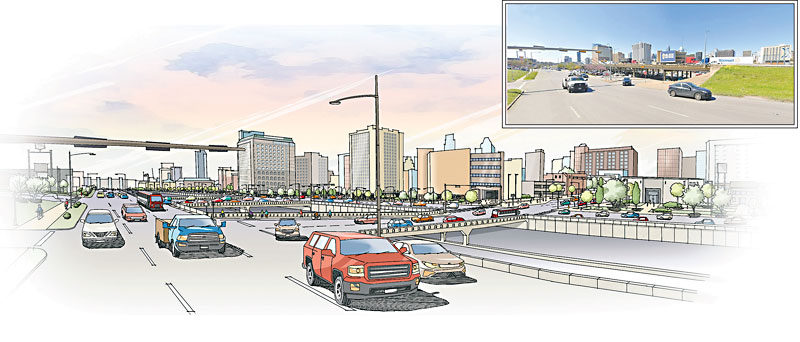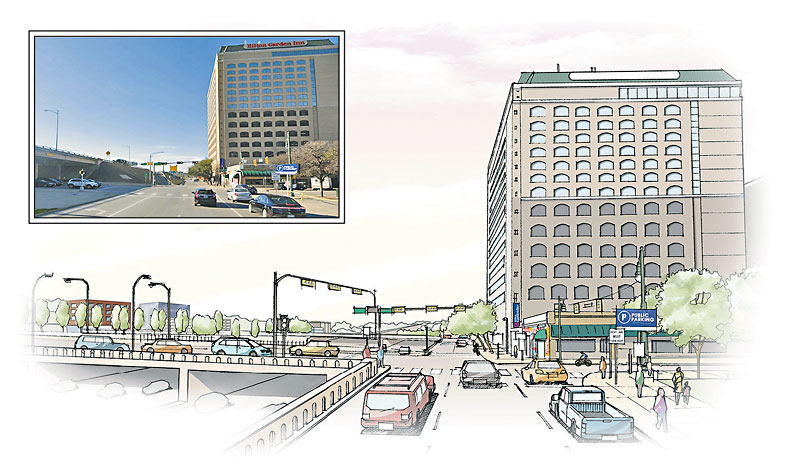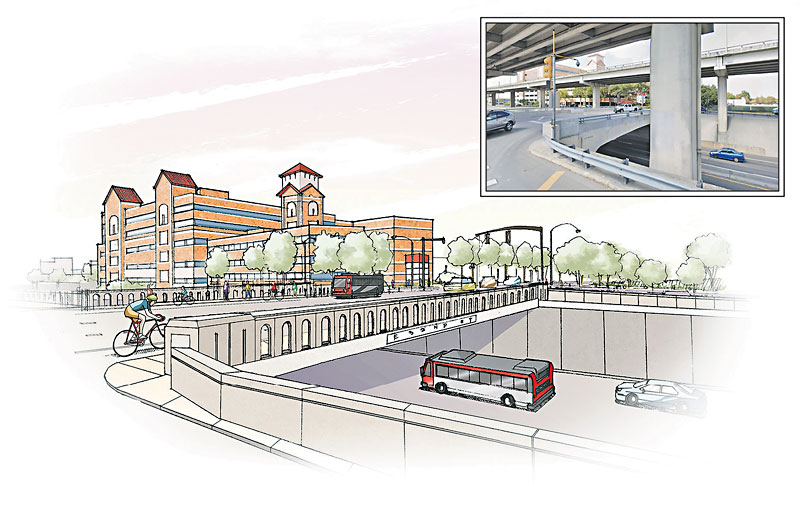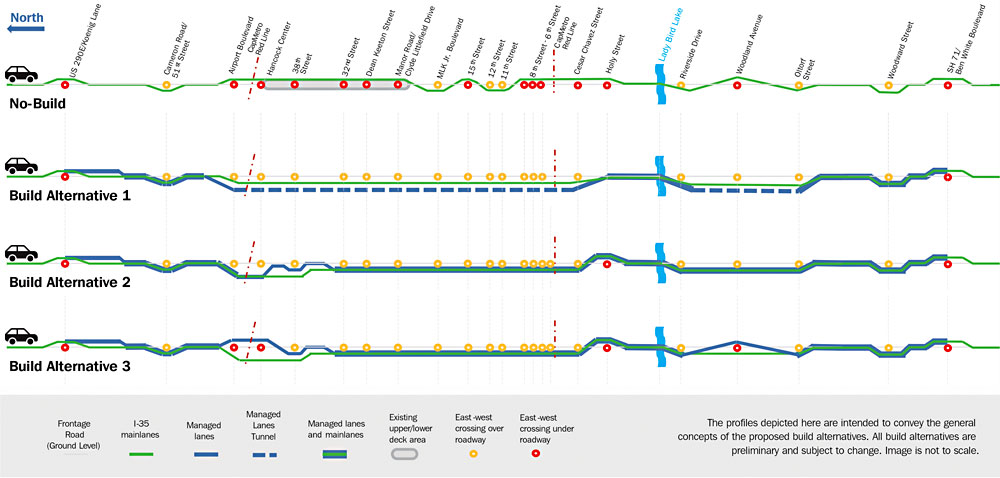Austin Leans in Hard to Change TxDOT’s Mind on I-35
The road not taken
By Mike Clark-Madison, Fri., April 2, 2021

As questions, concerns, and cries for help from thousands of Austinites, including City Hall itself and other powerful public and private stakeholders, pile up in the I-35 Capital Express Central comment files like cars stuck on the Brontosaurus Bridge, the Texas Department of Transportation wants you to know that you have been seen and heard. "During virtual scoping meeting #1, we received more than 2,300 comments, including comments on an interactive environmental constraints map," you'll read on the project website, where you can also view that map (but not comment on it directly; too late for that). "All comments have been documented and are being considered by the project team."
Typically, when a big project like the $5 billion CapExCentral – rebuilding the 8-mile center stretch of I-35 from U.S. 290 East (the Manor Expressway) to U.S. 290 West (Ben White Boulevard) – is being developed, the lead agency has to respond to every question or comment it receives from the public and from other government stakeholders ("coordinating and participating agencies") as part of the process. Right now is one of four designated opportunities for public engagement; we're in the "scoping" phase, which TxDOT has broken into two parts, one concluding last December, the other ending April 9.
The virtual open house online now includes a CliffsNotes version of those 2,300 comments, grouped and broadly summarized into 28 themes, none of which are really flattering to TxDOT. Some question whether we should be doing the CapExCentral at all. Most urge the agency to do it differently than it has currently sketched out, to better conform with Austin's local consensus regarding mobility and land use, environmental protection, and social equity. Many want to see change to the process now underway, with more robust and authentic community engagement, more time to comment, and more attention paid to issues that Austinites and their leaders feel and fear TxDOT will consign to the back burner.
Local stakeholders still have grave doubts that they were truly seen and heard in that first round of scoping last winter. Among those 2,300 comments are detailed responses and analyses from the city of Austin, Travis County, Capital Metro, the Downtown Austin Alliance, the Urban Land Institute, the Reconnect Austin and Rethink I-35 community coalitions focused specifically on the issue, and many others. All these folks have reiterated goals and visions and essential elements for reinventing I-35 that TxDOT has been hearing for years. Last week, City Council adopted a resolution that "reemphasizes to TxDOT the importance and value of the [city's] comments to the City of Austin and success of the I-35 project. The City Council urges TxDOT to take positive action on these comments in the same good-faith way they are offered."
In a separate letter to TxDOT on March 23, Council Member Greg Casar wrote, "For decades, I-35 has been an enforcer of division. We should be working to connect our communities, instead of making that division wider. I cannot support a project that conflicts with the city's connectivity goals and that could widen the highway unnecessarily without addressing the real traffic needs inside the city."
Not Too Late Yet, Maybe
In fairness to TxDOT, this is the point in the process when dunking on the agency and its project is, under the law, most valued and encouraged. The CapExCentral is much earlier in its gestation than is the I-45 rebuild in Houston, which was cleared for design and construction until it got halted on orders from the Federal Highway Administration (now under the authority of Pete Buttigieg and not Elaine Chao). The federal concerns are mirrored in a lawsuit filed against TxDOT on March 11 by Harris County. The sad, depressing tale told in that lawsuit is the same one folks are afraid will play out here, and which typifies so many urban highway projects in America.
Our Houston friends have been telling TxDOT for 10 years what they do and don't want from the I-45 rebuild – such as not displacing thousands of people. The city, county, Houston METRO, and most all other Harris County stakeholders have signed on to a specific alternative plan that TxDOT has largely ignored. So now they're in court. We are not there yet, and on TxDOT's current intended timeline, we won't be for two more years, with several comment windows to come.
To get the acronyms out of the way, scoping is the first phase of the National Environmental Policy Act (NEPA) process; it culminates in a finalized Purpose and Need Statement (P&N), which is the one-page version of "Why are we doing this?" The P&N shapes the criteria TxDOT will use to evaluate its alternatives – CapExCentral has three (see p.28), along with the obligatory "no build," and the agency says it will present its refined versions of these next summer, with another round of public engagement.
Then, as is typical for big projects like this, TxDOT will go dark for a while as it considers the public comment and a truckload of specific factors that fall into what NEPA broadly defines as "environmental impact," along with the preliminary engineering needed to cost out the project and mitigate those impacts. The draft Environmental Impact Statement (EIS) that follows, which will recommend the "preferred alternative" that best meets the P&N, is slated to roll out in fall 2022, which will be the last big public comment window. The final EIS incorporating that feedback, combined with the official Record of Decision to clear the CapExCentral for design and construction, will be ready in summer 2023, according to TxDOT – which has been delegated authority by the feds to evaluate its own work, as it did on I-45. (The CapExNorth and CapExSouth projects, extending from the U.S. 290 interchanges to the county lines, went through a lighter version of NEPA review.)
The alarms Austinites have raised about CapExCentral's efficacy, equity, and environmental sensitivity can and should be addressed in detail in the draft EIS; that's why we have NEPA. Any decisions TxDOT has already made to narrow its focus to the three alternatives being considered shouldn't preclude a rethink of what success here would actually look like. If the process is done right, it should take time and involve hard work and hard choices.
What's so frustrating to so many folks who care about America's sorry infrastructure is that NEPA too often takes a long time, and costs a lot of money, and doesn't reflect hard work and hard choices but rather the priorities of people with power and privilege who want to reduce their travel time and don't have to deal with the downside. Local stakeholders – apparently a lot of them, looking at the TxDOT summary of their "themes" – fear the agency will take two years to decide to rebuild the highway the way it's largely anticipated for the last several decades, only awaiting the funds to make it happen, without real attention to how much Austin has changed and how much harm I-35 has done over that time.

Zoom In and "Enhance"
The agency says its latest draft P&N, and the draft analysis criteria that flow from it, reflects Austin's goals for safety, connectivity, and compatibility with the Project Connect transit plan. It also continues to accede to the long-sought plans to depress the highway below grade and allow a "cap" over it to eliminate the nasty and highly symbolic barrier separating East and West Austin that I-35 is now. Mind you, TxDOT is clear that it's up to local stakeholders to pay for that cap – what it calls the "deck plaza local enhancements" – but it will evaluate alternatives based on how much they add to the feasibility and lower the cost of that construction.
Stakeholders think TxDOT can go a lot further here. One baseline factor is that fixing what I-35 has broken in Austin is not really called out in the P&N – the reasons for the CapExCentral do not include helping the city repair its damaged urban fabric, reduce its segregation and inequities, and reorient itself toward a less car-centered future. The traditional response from TxDOT is that all of that is beyond its purview, and that while a rebuilt I-35 cannot help but be safer and less disruptive and a better neighbor, the agency still has to center the needs of "the traveling public" and constrain the inevitable increase in travel times on the highway as Austin grows. (Actually "reducing congestion" is nonsense, even to TxDOT.)
Yet even with that set of policy blinders, TxDOT will still have to deal with many of Austin's concerns as it navigates the NEPA process. Unlike in many cities, the real estate that flanks the CapExCentral is not really devalued much by proximity to an ugly and noisy highway, but instead includes some of the most expensive dirt in Texas. That may work in favor of minimizing displacement and limiting TxDOT's traditionally profligate right-of-way acquisition, but it also intensifies the environmental impact that needs to be mitigated. Lots of people live near I-35; lots of important places can be found there; lots of harm to them has already been done and would still be done by a thoughtless rebuild that leaves out what's actually needed. That harm comes with a price tag that escalates daily.
"Environmental impact" under NEPA includes air and water quality, public health and safety both along and across the highway, preservation of open space and historic resources, and much else that I-35 affects. It also includes environmental justice and equity, and not just for show; Harris County in its I-45 suit claims that TxDOT not only didn't follow NEPA and specific provisions of state and federal transportation codes, but has also violated Title VI of the Civil Rights Act of 1964. For CapExCentral, TxDOT says it will conduct a "community impact analysis" within the EIS, beginning now, to address "potential impacts to people of color, minority and low-income populations, those with limited English proficiency, elderly populations, people with disabilities and children." What that process will look like is still somewhat nebulous to stakeholders, who would be valuable if not essential to that analysis and who've already given a lot of input to TxDOT.
An authentic equity analysis, for example, would probably need to consider capping I-35 not as an add-on "enhancement" for someone other than TxDOT to take on as an amenity for Downtown tower-dwellers along the lines of Dallas' admittedly awesome Klyde Warren Park. Rather, burying I-35 to the degree feasible – not just digging the trench, but covering it over – for the full 8 miles of CapExCentral might be essential to meet the project purpose and need and mitigate the environmental impacts on people and places that already struggle and suffer from their proximity to the highway. That's called out specifically by Casar in his letter to TxDOT.

We Were Promised Jetpacks
Casar also, as the political champion of the young Austin left, side-eyes the wisdom of continuing to enable and ease automobile travel, with the daily commute to and from work as the standard unit of measurement, while the needs of rising generations skew otherwise under the weight of history-changing forces. Lots of people say lots of things about how the future will validate their mobility preferences (flying cars!) but that doesn't mean you can just ignore shifts in the nature of work, in the use of built space, in the wealth and resources available to today's young people, and in the sustainability of life itself on a warming planet.
In the alternatives currently on the table, the biggest change to the status quo (other than going below grade and losing the upper deck between Airport and MLK) is the "managed" lanes that, along with variously widened at-grade frontage roads, represent the sole added capacity under the CapExCentral. How those lanes will actually be managed is officially undefined; TxDOT continues to say loudly that There Will Be No Tolls on the new I-35, nor will there be transit-only lanes, but many people think those prohibitions are not only bogus and unwise but basically impossible to maintain in the out years. Some of the grudging political support that cleared the way for CapExCentral to move forward is premised on the assumption that the managed lanes, and perhaps others, of the new I-35 will be tolled or transit-only once the current powers that be (starting with Gov. Greg Abbott) have left the scene.
Indeed, state Rep. John Cyrier, R-Lockhart, has introduced a bill that would allow TxDOT to partner with a private road developer to build out I-35 and toll some of its capacity. That's the model that 20 years ago was supposed to redefine transportation in Texas, until it became toxic with exactly the kind of Texans the GOP now depends upon to survive, and until the highest-profile yet least-needed local toll road, the southern leg of State Highway 130 from Mustang Ridge to Seguin (right though Cyrier's district), went bankrupt. It is at least a little brave to file a bill that would reverse what by now is reflexive hostility from Abbott and his appointees.
But Cyrier's main reason, he told the Statesman earlier this month, is to free up money for smaller needed road projects throughout the metro area, including the largely disadvantaged communities along and beyond the Eastern Crescent that he represents. "It's decades of funding that we're having to tie up for one project," he said. "Things have changed and we need to be creative."
What Cyrier is referring to is the decisions by TxDOT, the Texas Transportation Commission, and the local leaders who govern the Capital Area Metropolitan Planning Organization to fund the CapEx projects, totaling $7.2 billion at least, by sweeping up most of the available road funding for the region. There's not really much opposition among Austin leaders to tolling the new lanes on I-35, and there is still a sense among both locals and the Legislature that the CapExCentral may not need to be quite so big and costly in the wake of the pandemic, though what a viable "low-build" alternative would be is not yet clear. But for now, the hymnal from which everyone is singing says that I-35 is so important that other roads will have to wait. That will continue to raise the stakes for TxDOT to get the project right.
Visit capexcentral.mobility35openhouse.com to see TxDOT’s work to date and contribute your input before April 9.
I-35 Alternatives: Side-View Elevations Looking East
All three of TxDOT's "build alternatives" involve the main lanes of I-35 being lowered for much of the 8-mile stretch being rebuilt in the Capital Express Central project.
Alternative 1 is the most thorough, putting the mainlanes below grade from Airport all the way to the Lady Bird Lake bridge and then again south of the river to Oltorf, and tunneling the new managed lanes below these.
Alternatives 2 and 3 have no tunnels; both involve stretches near Hancock Center (and the Chronicle offices) where the managed lanes are cantilevered (2) or elevated above grade (3), in part to eliminate conflicts with the Capital MetroRail Red Line. Both 2 and 3 also go above Holly Street past the Rainey Street District, and Alternative 3 uses the existing I-35 elevation between Riverside and Oltorf for the managed lanes south of the river.
Got something to say on the subject? Send a letter to the editor.











